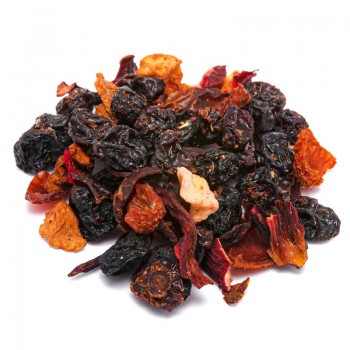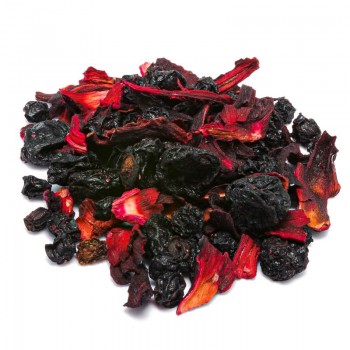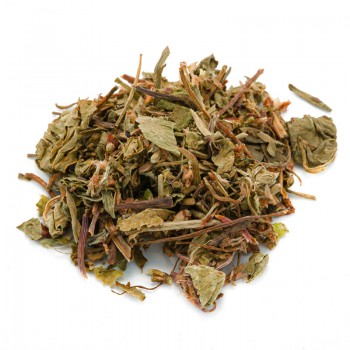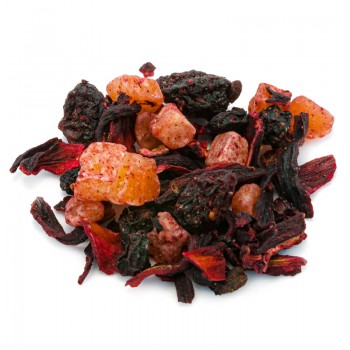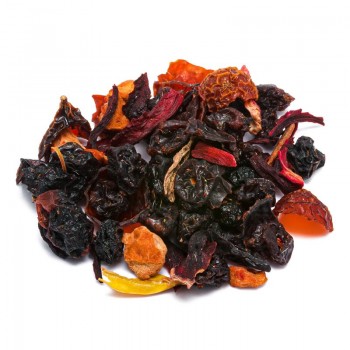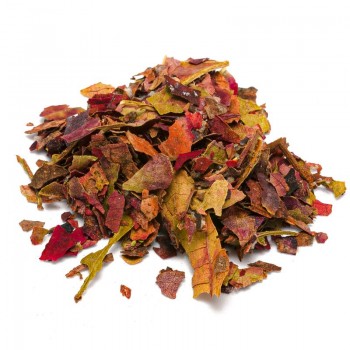The infusion of cranberry and vanilla becomes a greedy blend, thanks to two of the most popular scents. The result is an infusion with a fruity and intense flavor.
Cranberry, which gives a very marked acidulous note, is combined with delicate vanilla, to give not only a special taste, but several healthy qualities to our body.
Cranberry and vanilla infusion: properties and benefits
Cranberries contain a wide range of antioxidants, vitamins and minerals useful for female well-being. The anthocyanins and flavonoids in this herbal tea, together with the tannins, caffeic acid and resveratrol , are a source of anti-aging substances, useful for correct microcirculation and blood circulation.
The most notable benefits of cranberry tea are invaluable for heart health, therefore. This high concentration of beneficial substances makes the infusion excellent for preventing oxidative stress of the cells, and protecting the walls of blood vessels.
This beneficial effect on circulation and heart is enhanced by the antioxidants of vanilla, which with its sedative effect helps dilate arteries and lower blood pressure levels.
The cranberry and vanilla infusion is also valid for the well-being of the uro-genital system.
Being a diuretic herbal tea, it can promote purification starting from the intestine; in particular, it is useful thanks to the ability of blueberry to prevent the action of some inflammatory bacteria in the urinary tract.
Among these ingredients, those of vanilla can donate their properties of natural hormonal stimulation . This is why the consumption of vanilla is recommended for those who want to find a food that rebalances female and male hormones.
Especially vanillin , one of the primary chemical components of the vanilla bean, which can stimulate the hormone oxytocin, from the pituitary. Oxytocin helps uterine contractions and the onset of menstruation.
For women, vanilla can give benefits even managing to soothe the symptoms of PMS due to hormonal imbalance: mood swings, swelling, fatigue.
By relaxing the body and donating elements that stimulate hormones, the infusion can alleviate these symptoms. These qualities can be useful in several cases, giving relaxation, and benefit in the case of hot flashes in menopause.
Vanilla has a high content of magnesium, which is also useful for controlling the production of hormones that stimulate the functioning of neurotransmitters linked to PMS - those that cause mood changes .
The active ingredients of vanilla stimulate some hormones including estrogen and testosterone, bringing benefits to libido and sexual activity. Vanilla was traditionally considered an aphrodisiac, which arouses the sexual instinct, increases sexual pleasure and performance. It was used to alleviate the problems of impotence and decreased desire.
The vanilla component also helps in relaxation. The cranberry and vanilla infusion, in fact, can give the right relaxation, especially for those suffering from stress. Vanilla, in particular, has a positive effect on anxiety and to promote sleep.
In addition to this, the herbal tea is excellent for the well-being of the gums and oral cavity.
The properties of these ingredients of the infusion are also useful for helping digestion, calming inflammation of the intestine, stomach or episodes of diarrhea.
Thirst-quenching and invigorating if drunk hot, this infusion finds a great response even if it is prepared cold for the summer.
Origins and History of cultivation
Vanilla is a plant that probably has as its native land the territories of Mesoamerica - Mexico, Guatemala, Antilles; according to other researches it was also present in Java and Madagascar. Due to its aroma, it was used as incense by Mexican natives in ancient times, and over time it has become a valuable nutrient.
Today there are about 150 species known around the world and very well known are Bourbon, Tahitian and Indian vanilla.
To date, it is the plant of great commercial value, the largest in the world after the saffron plants; in particular in the vanilla varieties of Madagascar, Mexico, Indonesia and Tahiti.
Vanilla is a very laborious, and therefore expensive, agricultural product. It is due to the fact that the entire process of growing and harvesting the vanilla is done by hand, without using machinery, fertilizers or pesticides. Its flavor gives intensity to many foods, and recalls tropical origins with a note considered by many to be "mysterious". For this reason, it is widely used in perfumery for its charm and in aromatherapy for its calming effect.
American blueberry was used and known by native Indians, who used it for healthy recipes such as pemmican (along with meat and other fats, blueberries were also used as preservatives). In traditional medicine, the Indians to treat urinary infections, for oral hygiene, to heal wounds.
It spread after the discovery of America, through juices and jams. Famous is the blueberry sauce used in the holidays. It was also used as a prevention of scurvy for sailors, due to its vitamin C content
Today it is also cultivated in Europe and other countries of the Northern Hemisphere.
The European version of the cranberry, Vaccinium vitis idaea, has been widespread on our territory for centuries and has taken different names depending on the populations that used it.
Plant and flowers
The blueberry plant can derive from evergreen dwarf shrubs, part of the Oxycoccus subgenus of the Vaccinium genus: Vaccinium microcarpum or Oxycoccus microcarpus, Vaccinium oxycoccos or Oxycoccus palustris. They are found in North America and Chile, Northern Europe and North Asia.
Cranberries are shrubs, the fruits of which are formed by a berry larger than the leaves of the plant. The cranberry is born with a light green color, and tends to red when ripe. The fruits are sweet but also sour, but with a taste that usually blends with sweetness.
Vanilla Planifolia belongs to the Orchidaceae family (orchids) and can be grown in many tropical countries. From the long seeds of a vanilla orchid, this one was born, which represents the only edible fruit of the entire orchid family.
It grows best in humid and tropical regions of the world, as a climber up to about 12-15 meters in height. Only two species, Vanilla planifolia and Vanilla tahitensis, are grown for commercial use as a flavoring or perfume.
The fruit of the plant is the one that gives the aromatic principles, containing numerous seeds inside the capsule. If it remains on the plant and ferments, the pod gives its smell.
The raspberry comes from the Rubus idaeus bramble, of the Rosaceae family. It is a perennial plant, which only lives two years and many plants only bear fruit in the second year.
Although called a berry, raspberry fruit is technically an aggregate of small drupes, each containing a single seed.
The apple comes from the Malus domestica plant of the Rosaceae family. It is a tree native to Asia, now widespread throughout the planet. The fruits differ in colors and varieties, used for millennia in human nutrition for their beneficial action on digestion, and the supply of vitamin C.
The Rose is a plant of the Rosaceae family, native to Asia. There are thousands of cultivars of this plant, famous for its flowers, which can be of many shapes and colors. It can appear as an erect shrub, climbing, thorny or not. The flowers of the rose change in size and color from white to yellow and red.
Hibiscus (Hibiscus) is a flowering plant of the Malvaceae family, which includes hundreds of species, all native to warm temperate, subtropical and tropical regions. The species with large flowers are used to dry the petals, which give their beneficial properties.
Nutritional values of the cranberry and vanilla infusion
Vanilla is a good source of nutrients, vitamins and minerals. Contains manganese, copper, iron, potassium, magnesium, vitamin B2, vitamin B3 and vitamin B6 .
Blueberries provide the herbal tea not only with other minerals butdifferent polyphenol antioxidants; in addition to vitamins C, A, E and K
How to use the ingredients in the herbal tea
The infusion is obtained by putting in a cup (250 ml), about 3-5 grams, the mixture of cranberry and vanilla with water at 100 ° C.
Leave to infuse for 10 to 12 minutes, before drinking the herbal tea.
Add honey or sugar if desired.
Cranberry and vanilla infusion: side effects and contraindications
Given the presence of oxalate in blueberries, a salt that favors the formation of kidney stones, it is not recommended for use in people suffering from kidney problems.
It is good to consult your specialist on the intake of cranberries, if you suffer from bleeding risk as a patient on anticoagulants.
The vanilla component could cause headaches and excessive sleepiness. Furthermore, no data regarding safety during pregnancy or breastfeeding are known.




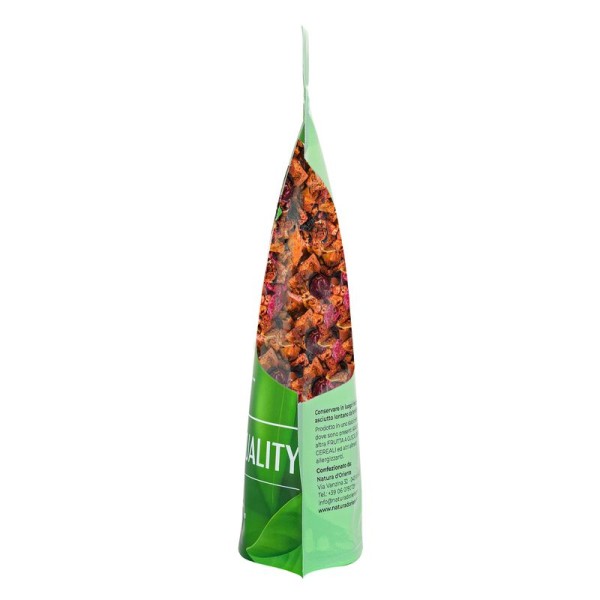






 No reward points for this product.
No reward points for this product.
![infuso frutti rossi [Natura d'Oriente]](https://www.naturadoriente.com/3542-home_default/infusion-of-red-fruits.jpg)
